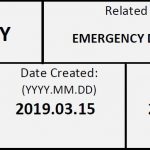A. Purpose:
To define and determine the procedures required for the collection of student information and its storage, use, disclosure, transfer, and protection.
B. Policy Statements:
The following policy statements are provided to inform all parties who collect, store, use, disclose, transfer, and protect student information.
VANDA School will:
• Ensure that the principal and one of the teachers are responsible for the establishment, security and maintenance of the Student Record and Student File for each student enrolled or registered in the school according to the procedures defined in this policy. All records will be updated with grades by the secretary during the summer before the school year begins.
• Only collect, use, or disclose personal information with the consent of the individual student or legal guardian, unless otherwise authorized under Personal Information Protection Act (PIPA).
• On or before collecting personal information, disclose to the individual student verbally or in writing the purposes for the collection of personal information.
• Only collect, use, or disclose personal information for purposes that a reasonable person would consider appropriate in the circumstances and that fulfill the purposes disclosed by the school or are otherwise permitted under PIPA.
• Secure Student Records and Student Files with access within the school authority restricted to those individuals who, by the nature of their work, are required to have access to the information.
• Provide access to personal information about a student to a parent or legal guardian of the student during school hours and under the supervision of the principal or designate.
• Subject to legal requirements and ensure that personal information will be retained only for the time required to fulfill the purpose for which it was collected.
• Inform parents that concerns, complaints, and questions about the personal information handling policies and practices of the school authority may be directed to the school’s Privacy Officer by calling the school office.
C. Definitions and Student Record Components:
1. Elements of the Student Record:
The Permanent Student Record (PSR) that contains relevant forms completed according to the permanent student record Instructions that is effective at the time of completion; and Student Progress Reports for the two most recent years or an official transcript of grades:
• All documents listed as inclusions on Permanent Student Record as below
• Enrolment/registration form, which verifies the information about the student’s parent or guardian
• A copy of the student’s current Student Learning Plan
• A copy of the student’s current Individual Education Plan (IEP), if any.
2. Permanent Student Record Inclusions:
The following inclusions will be listed on this form, including document date, title and expiry date or date rescinded (if applicable), and copies of the documents listed will be filed with the PSR:
• Health Services information as indicated by the medical alert checkbox, such as diabetes, epilepsy, anaphylaxis producing allergies, and any other condition which may require emergency care.
• Court orders indicated by the legal alert checkbox.
• Other legal documents such as name change or immigration documents.
• Support services information (e.g. psychometric testing, speech and hearing tests, adjudication requirements for completing assessment activities).
• Current IEP and/or Case Management Plan (CMP) where applicable.
• Notification of a student being home schooled.
The following inclusions may be listed on PSR Form, including document date, title and expiry date or date rescinded (if applicable) and if listed, copies of the documents will be filed with the PSR:
• Records of information which an educator deems relevant and important to the educational program of the student.
• Award information.
• Standardized test scores (if deemed relevant and important to the educational program of the student).
3. Student File:
Additional items will be included in the school’s student records as part of the Student File. These items include:
• Student eligibility information (required) including legal name of the child and a photocopy or scanned copy of the birth certificate or similar legitimate identification document; official name(s) of parent(s) or guardian(s) with home and work contact information; and verification that parent/guardian is legally admitted to Canada and a resident of British Columbia, Canada.
• Care Card number.
• Emergency contact numbers.
• Doctor’s name and contact information.
• Previous Student Progress Reports (other than the two most recent years required in the PSR).
• Serious discipline reports (e.g. copies of letters to parents/guardians regarding discipline matters and corrective actions taken).
• Reports of important meetings/discussions relating to the student.
• Standardized test scores, records of information which an educator deems relevant and important to the educational program of the student, and award information that is not listed as inclusions on the PSR.
4. Sensitive Student Information:
• This may include information, which by its nature, requires the school staff to hold a high level of confidentiality with psychiatric reports, family assessments, and referrals to or reports from school arranged counseling services, or record of a school-initiated report of alleged sexual or physical abuse made to a child protection social worker under section 14 of the Child, Family and Community Service Act.
D. Procedures:
1. The principal or designate will be responsible for updating the PSR Form as information changes and the student progresses through the system and for ensuring that electronic copies of documents are stored on a server in a physically secure location. If information is accessed through the Internet, an encrypted connection will be established before authenticating. Access is restricted to those employees (such as designated records clerks, administration, teachers, and counselors) who, by the nature of their work, are required to have access, which ensures that the school authority takes necessary precautions to safeguard against deprecated or outdated forms of storage. The electronic storage of PSRs and other personal information requires the school authority to have an adequate backup plan and recovery strategy for potential hardware failure and database corruption.
2. Student Record and Student File Retention:
a) Student Records – Active Students
• Student Records are locked in fireproof and waterproof cabinets. Access is restricted to those employees (such as designated records clerks, administrators, teachers, and counsellors) who, by the nature of their work, are required to have access.
• The school authority protects personal information from unauthorized access, collection, use, disclosure, copying, modification, disposal, or similar risks.
Procedures for such protection are outlined below:
• The principal or designate will regularly review Student Records to ensure that the information is current and complies with legal requirements.
• Required inclusions will be listed on the PSR.
b) Student Records – Inactive Students
• Unless another school requests a Student Record (see section 6 below), the school authority archives Student Records for 55 years after a student has withdrawn and not enrolled in another K-12 school or graduated from the school.
• The archived Student Records are stored securely and in a manner that ensures their preservation from calamity (fire, flood, etc.). Access is limited to the principal or vice principal.
• The designated records clerk keeps a record of Student Records that are destroyed (shredded) after 55 years.
c) Student Files – Active Students
• Student Files are locked in fire proof filing cabinets in school. Access is restricted to those employees (such as designated records clerks, administrators, teachers, and counsellors) who, by the nature of their work, are required to have access.
• The school authority protects personal information from unauthorized access, collection, use, disclosure, copying, modification, or disposal, or similar risks. Procedures for such protection are outlined in sections 5 and 6 below.
• The principal or designate will regularly review Student Files to ensure that the information is relevant and important to the educational program of the student.
d) Student Files – Inactive Students
• The school authority archives Student Records for 55 years after the student has withdrawn and not enrolled in another K-12 school or graduated from the school.
• The archived Student Records are stored securely and in a manner that ensures their preservation from calamity (fire, flood, etc.) Access is limited to the administration or designate.
• The lead principal or designate is responsible for determining the relevancy of the contents in Student Records before being archived.
3. Currency of Student Records:
Student eligibility information will be updated during student registration each year. As stated above, the principal or designate will regularly review Student Records and Student Files to ensure that the information is current and complies with legal requirements.
4. Security of Student Information:
The lead principal is responsible for ensuring that personal information is safely stored, and that personal information is protected.
5. Handling Sensitive Student Information:
Access to Sensitive Student Information is restricted to the principal or person(s) authorized by her/him to access such information defined in this policy. The principal or designate will obtain parental consent (written, dated, and signed) for the collection, use and disclosure of Sensitive Student Information, including psychiatric reports and family assessments, and will store these as highly confidential documents with restricted access. Sensitive Student Information will only be disclosed or transferred under the law. The principal is responsible for ensuring that school-initiated reports under section 14 of the Child, Family and Community Service Act are retained only for child protection proceedings and that information is not disclosed to third parties or transferred to other schools. Such reports are strictly confidential and will only be stored where the principal or designate can access them.
E. Use of Student Personal Information:
VANDA School will use an individual student’s personal information for the following purposes, if the school has disclosed such purposes to the individual student verbally or in writing or before collecting the personal information:
1. To communicate with the student and/or the student’s parent or legal guardian, process a student’s application, and provide a student with the educational services and co-curricular programs provided by the school authority.
2. To enable the authority to operate its administrative function, including payment of fees and maintenance of ancillary school programs, such as parent voluntary groups and fundraising activities.
3. To provide specialized services in areas of health, psychological or legal support, or as adjunct information in delivering educational services that are in the best interests of the student.
F. Access to and Disclosure of Student Records:
1. A student (capable of exercising PIPA rights) and a parent/legal guardian of a student is permitted (unless restricted by a court order) to examine the Student Record and Student File kept by a school authority pertaining to that student, while accompanied by the principal or designate to interpret the records; and receive a copy of any student record upon request. The school authority reserves the right to recover the direct cost of copying records.
2. An entitled person may access and verify personal information in the Student Record and Student File pertaining to the student with appropriate notice to the school administration. Access will be provided during school hours.
3. Access to a Student Record or Student File will only be granted, upon assurance of confidentiality (with consent), to professionals who are planning for or delivering education, health, social or other support services to that student. Consent will be obtained in writing, listing the name and date of birth of the student, the name and signature of the parent/guardian, and the date of the request.
4. There is no need for consent to share student information to the Ministry of Education, Ministry of Health and Ministry of Children and Family Development.
5. When applicable, graduating students will be provided with interim and/or final transcripts for Grades 10, 11 and 12 courses when graduating, and upon future request of the graduate. Copies will be mailed directly to institutions of higher learning or as requested by the graduate. The school authority reserves the right to assess a reasonable fee for transcript requests.
6. In the case of a request for personal student information from separated or divorced parents, the school authority will be guided by the legal custody agreement, a copy of which will be provided to the principal. In cases where the principal is unsure if the non-custodial parent is entitled to access personal student information, the school’s legal counsel will be consulted for a recommendation.
G. Transfer of Student Records:
1. On receipt of a request for student records from a school, a Board of Education, or an independent school authority from within British Columbia where the student is (or will be)
Page | 9
enrolled, the school authority will transfer that student’s PSR (including declared inclusions), the current Student Learning Plan (if any), and the current IEP (if any) to the requesting institution. The school authority will retain a copy of the PSR, indicating the school where the records have been sent and the date of the student record transfer.
2. If the requesting institution is outside British Columbia, a photocopy of the PSR will be sent (including declared inclusions), along with the current Student Learning Plan (if any), and the current IEP (if any).
3. Requests for a student’s record from a public school require that the public-school administration provide a copy of the PSR (including declared inclusions) and current Student Learning Plan (if applicable) and IEP (if applicable) to the independent school authority. The original PSR will be retained by the public school.
4. The school authority will only transfer sensitive, confidential information (e.g, psychiatric assessments) after dated and signed parent/guardian consent has been obtained.
5. The school authority will not transfer a record of a Section 14 Child, Family and Community Service Act report of alleged sexual or physical abuse made to a child protection social worker.
6. A summary of a former student’s school progress may be provided to prospective employers, at the written request of a former student. The school authority reserves the right to assess a fee for this service.
7. A Student Record will be reviewed when a student transfers have made. The principal will ensure that the documents listed as inclusions are still required inclusions or still deemed to be relevant and important to the educational program of the student. Expired, rescinded, or irrelevant inclusions will be removed from the Student Record and the documents themselves will be shredded.
























